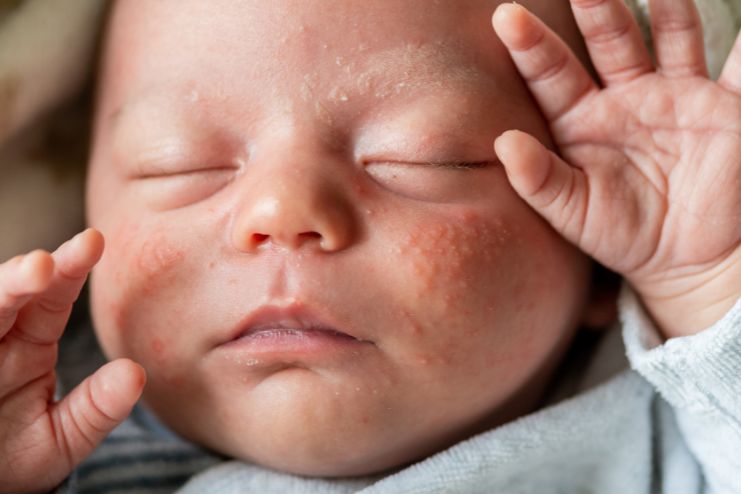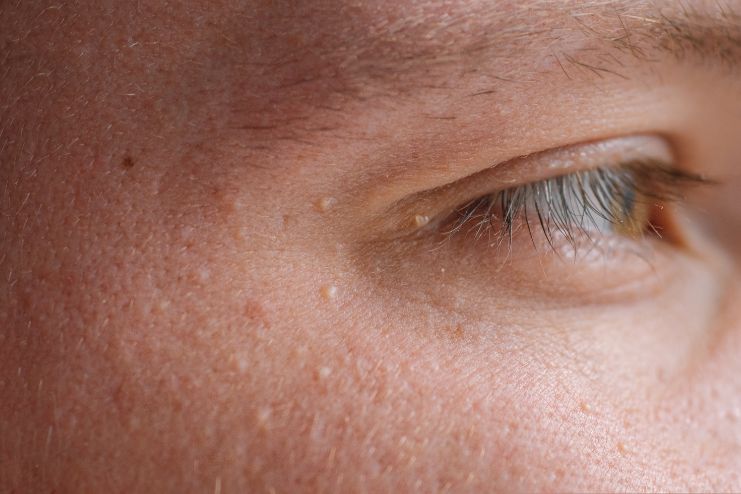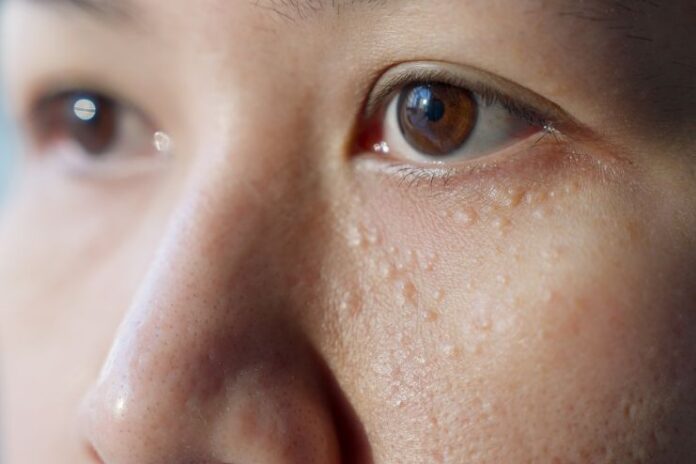AI Contribution
At HealthSpectra, we may use AI to refine grammar and structure, but every piece is shaped, checked, and approved by real people, our expert writers and editors, to ensure clarity, credibility, and care. Learn more..Affiliate Disclaimer
Some links in this article are affiliate links. We may earn a small commission if you make a purchase through these links, at no extra cost to you. We only recommend products we find useful to our readersHave you ever had little, yellowish, or white pimples under your skin that don’t break out like normal ones? We refer to these tiny lumps as milia. They are small and usually show up just below the skin’s surface. Despite the fact that they may resemble whiteheads or acne, they are not brought on by germs or clogged pores. That is a typical misunderstanding.
Milia can affect people of all ages, including adults, children, and babies. Although it typically goes away on its own, many newborns are born with it. Adults may get milia due to aging, skin injury, or poor skincare practices.
This article will discuss the causes of milia, its various forms, its effective treatments, and safe and natural ways to eliminate it. You’re at the right place if you want clearer, smoother skin or are looking for solutions to stop those obstinate pimples from showing up.
Read More: Batana Oil Benefits – The Secret to Stronger Hair and Glowing Skin
What Are Milia?
Milia are tiny, pearly white cysts that develop beneath the skin and are also known as milk spots. They appear when the protein keratin in the skin, hair, and nails becomes stuck beneath the surface. Milia can develop at any age, although it affects about 40% of newborns.
Although benign, milia can also develop due to skin injuries such as burns, blisters, or rashes. The cysts usually disappear in a few weeks, and the precise origin isn’t always recognized. Over time, this debris solidifies and gathers to create tiny, complex cysts.
In the United States, milia affects around 40% of babies but can also strike adults. You can try at-home remedies or have them removed by a medical professional if they continue for months or years.
Types of Milia

Neonatal Milia (Baby Milia): According to estimates, milia may affect as many as 50% of all babies. After a couple of weeks, they usually disappear on their own. Although neonatal milia most frequently appears on the nose, it can also appear on the head, cheek, upper trunk, and inside the mouth.
Keep in mind that there are differences between neonatal acne and neonatal milia. Unlike the white pimples of newborn acne, which often vary in size and show redness, milia usually appear uniform and lack any redness.
Primary Milia: Primary milia often appears as small cysts on the forehead, cheeks, genitalia, or eyelids. It affects adults and children and can last a few months without treatment, although it may also disappear independently after a few weeks. Additionally, in young toddlers, it may appear at the nasal crease.
Secondary Milia: Secondary milia, also known as traumatic milia, are very tiny cysts that develop following skin damage from burns, rashes, blisters, or exposure to sunlight. They may also develop as a reaction to a thick skin lotion or ointment.
Milia en Plaque: An autoimmune skin condition, like discoid lupus and lichen planus, often causes this kind of milia. It typically occurs on the face and is significantly larger than normal milia. The margins of these skin patches or plaques are usually clearly defined. People of all ages can contract Milia en plaque, but middle-aged women are more likely to have it. It usually appears behind the ears, cheeks, jaw, and eyelids.
Multiple Eruptive Milia: This uncommon type of milia is characterized by the slow development of several bumps in the same area over a few weeks or months. Although this is frequently the only symptom, the afflicted area could also experience irritation or itching. The face, upper arms, and upper trunk are the most common places for these milia to appear.
Read More: Gua Sha for Lymphatic Drainage: Does It Work Beyond Skincare?
Causes
Your skin continuously sheds old cells to create space for new ones. When this mechanism isn’t functioning properly, dead cells may become stuck beneath the surface, harden, and develop into milia.
Many milia instances, particularly neonatal milia, have no known cause. But in other situations, specific elements might have a role in their formation, such as:
- Skin damage brought on by burns, rashes, injuries, or exposure to the sun.
- Chronic corticosteroid usage
- Autoimmune and genetic disorders
- Aging of skin, since the skin gradually loses its dead cells
- Skin disorders that cause blistering
What Triggers Milia in Adults?

Milia can be annoying, particularly when they appear out of the blue. Several typical lifestyle and skincare variables can cause these tiny white bumps on the skin. Understanding these triggers is essential for effective prevention and developing the proper skin care for milia-prone skin.
- Excessive exposure to sunlight traps dead skin cells beneath the skin and stops them from shedding regularly.
- Skincare items that the skin does not adequately absorb.
- Petroleum jelly cream application. Petroleum jelly lotion can soften and hydrate the skin, but may also block pores, increasing the risk of milia.
- Prolonged application of steroid creams.
- Traumatic skin injury, such as dermabrasion techniques (which smooth the skin by removing its outer layer), can develop secondary milia as the skin heals and traps keratin beneath the surface.
- Possessing certain skin disorders, including dandruff, rosacea, and eczema.
To prevent future breakouts, you must understand the difference between milia and whiteheads and adopt targeted skincare for milia-prone skin.
Read More: Mud Therapy: Can Clay Heal Your Skin & Detox Your Body?
Treatment Options: How to Get Rid of Milia
Milia can be treated in several ways if they bother you, even though they are usually benign and self-resolving. You may want to think about the following treatment options:
Treatments Over-the-Counter
Over-the-counter medications with chemicals like adapalene (Differin), glycolic acid, or salicylic acid may work well for the first course of treatment. These products aid in skin exfoliation and stop dead skin cells from obstructing pores, which could otherwise result in the development of milia.
Prescription Drugs
For severe or persistent milia, your doctor may prescribe topical retinoids, vitamin A derivatives that aid in promoting cell turnover and preventing the creation of new milia. Doctors may recommend an oral antibiotic such as minocycline for milia en plaque.
Expert Care
Clinicians have developed several successful treatments to eliminate milia effectively. Among them are:
- Curettage: After numbing the area and “scooping” up the milia, the dermatologist will seal the skin with a hot wire.
- De-roofing: A professional uses a sterile needle or blade to remove the milia.
- Cryotherapy: Liquid nitrogen is used to remove the milia. Blisters and swelling are possible adverse effects, although these should disappear in a few days.
- Minocycline: This oral antibiotic works well against plaque-forming milia and other milias.
All of these methods, except the medicine minocycline, can potentially leave scars, although temporary ones. It is incredibly uncommon to experience severe side effects or permanent scars.
Is it possible to Eliminate Milia at Home?

As with a pimple, you should not attempt to squeeze or scrape off milia alone. It may result in an infection or skin scarring. There are several helpful things you can do at home:
- Wash your face with mild soap and warm water every day. Then, gently pat your skin dry.
- Avoid using oils or lotions intended for adults or infants. The skin of infants is too sensitive.
- Adults who want to exfoliate their skin might try an over-the-counter product.
Read More: Best Red & Near-Infrared Therapy Panels for Skin & Healing
How to Prevent Milia from Forming
Certain skincare practices can help lower the chance of having milia later in life, even if it is not always possible to prevent it, especially in babies. Here are a few successful tactics:
Exfoliate:
Blockages in hair follicles can result from dead skin cells building up on the skin surface. Dermatologists advise using a mild exfoliating scrub or cleanser with beta hydroxy acids (BHAs) or alpha hydroxy acids (AHAs) to combat this. By removing the dead skin cells from the skin’s surface, AHAs like lactic acid and glycolic acid help to smooth out the complexion and stop the accumulation that can lead to milia.
Keep Your Skin Clean:
Cleanse your skin frequently to remove perspiration, oil, and debris that can clog pores. Avoid hard washing, which can irritate the skin and cause extra problems, and instead use a gentle cleanser appropriate for your skin type.
Choose Oil-Free Items:
Making the correct skincare product choices is crucial to avoiding milia development. Tretinoin is especially effective at preventing milia. It is essential to use non-comedogenic and oil-free formulations to avoid clogging pores, which lowers the chance of developing milia. Non-comedogenic cosmetics help maintain clear skin using lightweight formulas less likely to clog hair follicles.
Apply Sunscreen before Leaving the House:
Create a skincare regimen that shields you from the sun since solar damage might result in milia. Since up to 80% of external skin damage is caused by the sun’s rays, wearing sunscreen should be your priority if you want to avoid developing milia. Because it protects from UVA and UVB radiation, choose a broad-spectrum sunscreen with SPF of 30 or higher. Applying sunscreen consistently before going outside creates a strong barrier that protects your skin from potential damage that could cause milia.
When to See a Dermatologist
Even while they are usually benign and go away independently, medical assistance is sometimes required. If keratin-filled cysts don’t go away after several months of regular at-home care,
Man, it could be time to see a dermatologist. New parents may initially be worried since they do not anticipate seeing milia on their baby’s face after delivery. It is the best course of action if your newborn has milia. The best action is to have your healthcare provider look at it because other newborn skin disorders can show similar.
Other warning indicators that call for a medical checkup include spreading, irritation, redness, or discomfort. In these situations, a dermatologist can determine if the pimples are milia or a skin disease that mimics it.
A dermatologist can provide professional milia removal utilizing sterile and safe methods to avoid scarring or additional inflammation. Depending on your skin type, they suggest the best exfoliants for milia, such as mild chemical exfoliants like glycolic acid or salicylic acid.
Read More: Slugging vs. Skin Cycling: Which Skincare Trend Is Right for You?
Conclusion
Even though Milia are tiny, they can be stubborn skincare issues. These keratin-filled cysts resist standard pimple therapies because, unlike acne or whiteheads, clogged pores or germs do not cause them. You can avoid recurrent outbreaks by being aware of the causes of milia, which range from aging and skin injuries to sun damage and excessive skincare products.
By utilizing appropriate skincare for milia-prone skin, which includes gentle exfoliation, non-comedogenic product use, and adequate skin care, you may enhance the texture of your skin and lessen the visibility of these tiny white bumps.
Do not be afraid to consult a dermatologist for professional milia removal if your milia worsens or persists. Depending on skin type, they can recommend the best exfoliants for milia and safely extract them.
FAQs
Are Milia the same as whiteheads?
No, whiteheads and milia are not the same thing. Although they look like little white pimples, milia are tiny cysts containing the skin protein keratin, whereas whiteheads are clogged pores.
Can you pop Milia?
You shouldn’t attempt to squeeze or pop the milia because doing so can cause infection and scarring. Milia are tiny, harmless cysts that can cause skin damage if you try to remove them yourself.
Will Milia go away on their own?
Indeed, milia usually go away independently in a few weeks to months, especially in infants, and don’t usually need to be treated by a doctor.
What’s the fastest way to remove Milia?
For the quickest milia removal, consider having a dermatologist perform manual extraction, which uses a tiny needle to puncture and remove the milia. Although chemical peels, laser resurfacing, and cryotherapy (freezing with liquid nitrogen) offer additional options, many dermatologists consider manual extraction the fastest method.
Can certain foods cause Milia?
Although the precise origin of milia is uncertain, some evidence indicates that dehydration and a high-cholesterol diet may raise the risk, while avoiding foods high in cholesterol and drinking enough water may help lower the risk.
Does retinol help with Milia?
Retinol can help cure and prevent milia by promoting skin cell turnover, which clears clogged pores and stops the accumulation of dead skin cells that cause milia.
References
- https://www.webmd.com/skin-problems-and-treatments/what-to-know-about-milia
- https://www.verywellhealth.com/description-of-millia-15572
- https://my.clevelandclinic.org/health/diseases/17868-milia
- https://www.pinebeltderm.com/everything-you-need-to-know-about-milia-types-causes-prevention-and-treatment
- https://www.healthline.com/health/milia#causes
- https://skinsight.com/skin-conditions/milia/
- https://www.siloamhospitals.com/en/informasi-siloam/artikel/milia-causes-symptoms-types-and-treatments
- https://www.vitalskinderm.com/conditions/milia
- https://www.medicalnewstoday.com/articles/320953#risks
- https://www.dearbrightly.com/how-to-get-rid-of-milia/
- https://myacare.com/procedure/milia-removal
In this Article


















